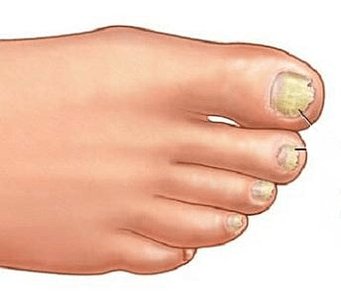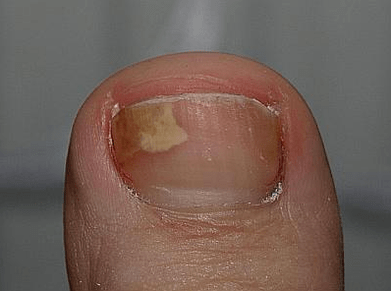
Nail fungus in the legs is a disease that is very easy to infect and much more difficult to cure.The nail fungus does not disappear on its own and it is very difficult to deal with.
How can you get a nail fungus infection
Six to eight percent of the adult population suffer from nail fungus.
Fungal nail infection is more common in men than in women, as well as in the elderly than in young people.Additional signs or factors that increase the risk of fungal nail infection include:
- Reduce blood flow to the legs.
- If the nails grow slowly.
- Family history of fungal infection (genetics).
- Increased sweating of the legs.
- Work environment - wet or wet legs.
- wearing socks and shoes that prevent ventilation.
- Walking barefoot in wet public spaces (pools, sports halls and shower).
- injuries or infections of the skin or nails.
- Diabetes, aids, circulatory problems, the impaired immune system.
- Hard shoes with pressure on the fingers.
Systematic diseases, for example: in the fungus of foot, predisposition to the fungus
- diabetes mellitus,
- portliness,
- anemia,
- Hormonal disorders,
- gastrointestinal disorders,
- immune and cardiovascular systems,
- as well as long -term treatment with antibiotics,
- Taking steroid therapy and chemotherapy.
Heat and humidity contribute to mushroom growth - if you do not wipe your feet well after washing, walk in air shoes and wear synthetic socks.The fungus grows when the nail plate is damaged-I used to cut a very short cut on the legs, it can easily get under the nail.Wearing narrow shoes can weaken the nail plate, such as acrylic nails and varnishes.
Omocycosis more often affects the legs in the feet than in the hands.May be limited by a plate or move to neighboring.Usually, fungal nail infections on the legs affect the thumb and the little finger.Probably because the inner surface of their shoes touches most of them.
Types of nail fungus
Fungal nail infections are caused by tiny organisms that do not require sunlight to survive.In most cases, it is a group of mushrooms called dermatophytes (for example, candida).However, some dough and mold also cause these infections.
Although Trichophyton leather are the most common cause of nail fungus infection, Trichophyton Interdigitale, Epidermophyton Floccosum, Trichophyton Vioaceum, Microsporum Gypseum, Tonsurans Trichophyton and Trichophyton Soudanense canalso lead to infection.Common Fungus Forms - Neoscytalidium, Scopulariopsis and Aspergillus.
The pathogens of the nail fungus, as a rule, fall under the skin through tiny cuts or small cracks between the nail and the nail bed.They grow when their environment provides a warm and humid climate.
How the nail fungus looks like - symptoms

In the initial stage The nail that is infected with fungus gradually changes its appearance.The strips appear - first white, then yellowish and finally brown.Peeling occurs on the nail, relaxes and becomes thicker, it becomes difficult to cut.Nail smells bad because fungal deposits accumulate under the nails.
The doctor, during the examination, may immediately determine the onnocycosis.Sometimes, however, the image of the disease is not clear and laboratory tests should be performed.Samples taken from nails and fragments of nail plates under a microscope can confirm that the disease is actually caused by mushrooms.Sometimes a fungus is cultivated in the laboratory from the sample to determine the species and the selected drug.
Before choosing, you cannot paint your nails, lubricate your feet with creams or powders.
In the second stage - Nails infected with fungi usually dense, become fragile, break, worn, curved, dull and dark, yellowish or brown.
The patient may also suffer from onyxification when the nail areas are absent, exposing the nail bed.Sometimes fungal nail infections can lead to finger pain and cause an unpleasant odor.
Another symptom associated with fungal infections is damage to the skin near the nail.There may be a rash or itching that looks like an allergic reaction.
Diagnosis of nail fungus
To diagnose nail fungus, as a rule, the doctor must study cuts and microorganisms under the nail.
Doctors should be careful when diagnosed with fungal nail infections due to some other conditions that can cause such symptoms.These include psoriasis, red flat lichen, contact dermatitis, injuries, nail bed tumors, eczema.The culture of the fungus can take several weeks.
How to specify nail fungus at home
It is very simple to do it:
We will need potassium permanganate (potassium permanganate), water and basin.
Take water in the basin so that it completely covers the legs of the feet.Pour a small potassium permanganate into the water so that the water becomes bright - pink (fuchsia color).Put your feet or hands in the water for 5-10 minutes.
Then we take out and carefully examine the nails.If they have become completely coffee, then all is well - the nails are healthy.But if there are areas that have not changed the color - they are infected with nail fungus.
Treatment of nail fungus
The treatment of nail fungal infections can be a long and expensive process.
Oral drugs to treat the infection, as a rule, should be taken up to four months until the replacement of a fully contaminated nail on the finger.These medicines are prescribed by a dermatologist according to certain shapes.Since drugs act on the liver and blood synthesis, it is necessary to test before and during treatment.
At the initial stage of the fungus, local drugs - ointments and varnishes help well.
Local Antimitation - The most effective means of local therapy, as they are more active than the pathogens of onychomycia.Among the many local drugs against nail fungi, only 2 can be called drugs to treat onychomycia itself, since they are available in the most appropriate form for this - in the form of nail polish.Other antifungal drugs are most commonly used in the treatment of fungal infections of the skin.
Lacquer
Special nail polishes designed to treat nail mussels allow you to better perform antimicocys through the nail plate deep inside the nail bed.In addition, the varnish membrane, freezing on the surface of the nail, prevents the evaporation of the drug from the nail and creates a barrier for infection.
The main advantage of modern varnishes used in the treatment of onychomycosis is that they can be applied to the nail plate without removing it.Other medicines cannot penetrate the nail plate, which requires its preliminary removal or at least significant dilution.
Today's antimicocytes, which are part of the varnishes, delay the nail for a long time after application, are maintained effective concentrations for at least 7 days.This allows varnishes 1 or 2 times a week.
The Batrafen varnish is applied every other day for the 1st month of treatment, 2 times a week for the 2nd month and then once a week.
Before starting treatment, any varnish should be removed, as many of the affected nail plates.The rest of the nail plate to which the varnish is applied must fall down with the attached file to create a heterogeneous surface.The varnish is applied with the attached brush or spatula.Before each varnish application, the previous layer is removed using a solvent or the alcohol tampon and a nail plate is treated with a file.A layer of varnish can be removed by placing a nail in warm water and scraping the scissors.
The duration of treatment depends on the speed of cultivating a healthy nail plate.For the treatment of onychomycia, there are several 6 months in the hands, in the feet-9-12 months.
Real methods of local fungus therapy include nail polish, such as Cyclopirox except other creams.Local ointments and creams can cleanse nail fungal infection, but often do not cure the infection completely.
In some extreme cases, the doctor may recommend nail removal.
Alternative medicines used to treat fungal nail infections include Australian tea extract and grapefruit seeds.However, there is no scientific evidence to support the use of these products.
Effective antifungal drugs
There are 3 effective antifungal drugs for oral administration (orally).All three drugs have serious side effects and can interact with many other medicines.Patients taking antifungal drugs should take periodic tests to test the function of the liver and blood cells.Octus antifungal agents continue to work even after treatment with the drug.
None of the oral antifungal agents can be taken during pregnancy.
Prevention
- Put a new pair of socks every day.The socks must be made of natural fibers such as silk, wool or cotton.These fibers allow moisture to remove from the foot and help distribute the air around the thumb of the foot and the foot.If your legs or socks are wet from the sweat, you should remove them as soon as possible, dry your feet with a clean towel and put in a new pair of socks.
- Wearing the same pair of shoes, day by day, it can have a negative effect on the legs and expose you to bacteria and fungi.When storing shoes, you need to make sure it is stored in a well -ventilated room for complete drying.It is advisable to have a lot of sneakers and change them before going to the gym so that these vapors have the optimum drying time.And finally, wear shoes in front of the entrance to the shower, sauna or gym.This is fertile soil for fungi that cause onychomycosis and other bacterial infections.
- There are ways to avoid infection and help a manicure specialist and pedicure to prevent nail fungus before it begins.The first sentence, bring your varnish with you.This is an easy way to avoid infection when using a general varnish - when the fungus falls directly to the nail bed.The second proposal is the requirement to sterilize all the equipment for manicure and pedicure.Each device must be disinfected and stored properly.And finally, the bathtubs for pedicure.This is a blessing for bacteria, which only expect to infect your nails.If you are not sure the bathroom was cleaned with the corresponding disinfectant after each customer, try to avoid this at all costs.
- Fungal infections are a common sign of an oppressed immune system.Enriching your diet with nutrients and vitamins, of course, can help prevent bacteria.Eat more garlic to eat.Tea oil is also a natural antifungal agent.Peel the nail area at the feet of tea oil.Black black walnut extract can also work well in the prevention of onychomycia.
- General use can lead to infections and cause nail fungus on the finger.The fungus can be transmitted from person to person.The maximum prevention is not to divide towels, shoes, scissors with someone else.And, as we always recommend, to cure the nail fungus in the dermatologist in the first signs of infection.

























